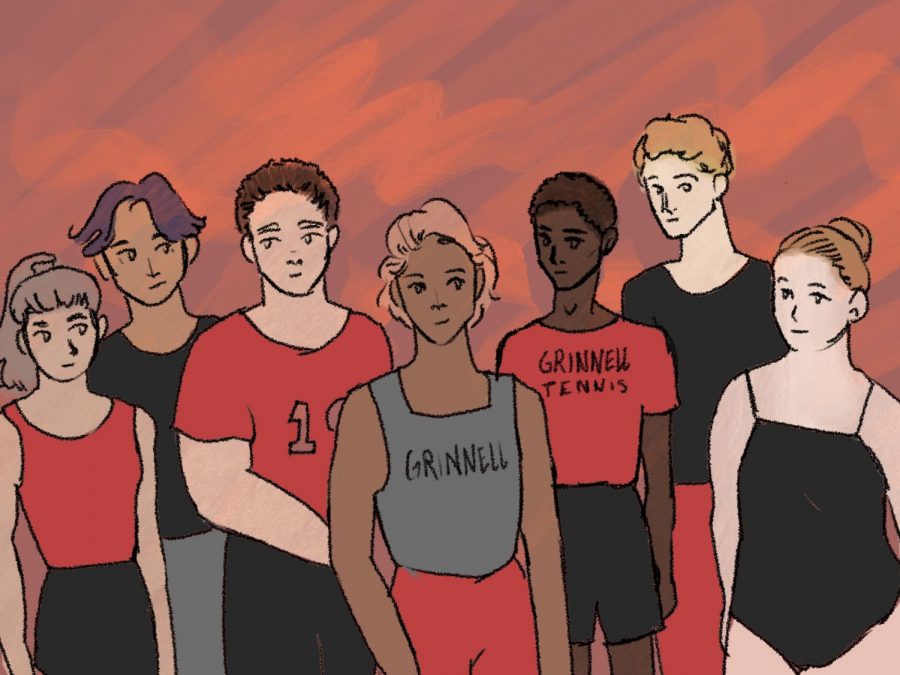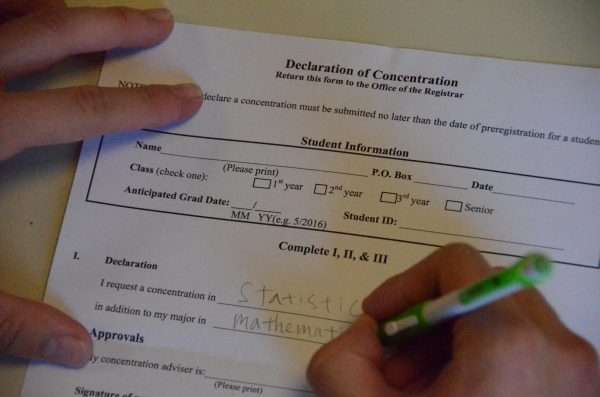Addressing the stigma: It’s time to talk about eating disorders
February 28, 2023
CW: In this series, I will be discussing eating disorders and their devastating effects. As someone who has an eating disorder, I try my very best to never describe specific behaviors or comparative numbers, as that can be very damaging, but the material may be upsetting nonetheless. If you decide not to read, thank you for taking care of yourself.
In the last installment of my series I explained my inspiration for investigating eating disorders on campus and within the athletic department. In this edition, I will delve into the stigma and lack of information on campus surrounding eating disorders.
I reached out to dozens of athletes over several months as part of my investigation. I emailed entire sports teams to explain my project and asked if anyone would talk with me about team cultures surrounding food, body image and what resources were provided to them — by coaches, captains and Student Athlete Mentors (SAMs).
During my outreach, two notable things happened that both spoke to the deep stigma that still exists surrounding eating disorders. First, the majority of respondents stipulated that they would only speak with me anonymously, expressing that the topic was too sensitive to discuss publicly. Second, I received a scolding email from an athlete accusing me of causing harm and instructing me to warn people about triggering content, i.e. eating disorders.
I was stumped. As a journalist, I always try to assume blame for my mistakes and correct any harm that I might have caused, but I couldn’t figure out a better way I could have approached reaching out. I did not mention behaviors or ask for them to share their personal struggles — really, I hadn’t given them any information at all. All I did was allude to the fact that there were eating disorders among athletes. The athlete’s response, however, highlighted another reason why eating disorders are still such an issue on campus — if we can’t even say the name of the issue we are facing, how are we ever going to be able to overcome it?
Erin Hurley, head coach of Grinnell’s swim and dive teams, told me, “We normalize depression and anxiety, which is part of an eating disorder. But, I think we could do more on the desensitization of the topic, so it’s not a hot topic or one that you have to tiptoe around.”
As part of my investigation, I wanted to talk to an array of athletes to try to understand different conceptions existing surrounding eating disorders. At the end of each of my interviews, I asked the interviewee what they thought made having an eating disorder so difficult. People with disordered eating experiences discussed the mental toll, explaining how it took control of their life and thoughts. But, those without personal experience focused on the physical side, describing the danger of undereating. This contrast in responses demonstrated to me the lack of eating disorder education among athletes.
I believe the ability to talk about eating disorders would be made much easier if everyone had a common understanding of what an eating disorder truly is and why it occurs. Let’s start with the fact that eating disorders are a psychological disorder — an addiction, not a diet or choice. I have always found it most useful to think of eating disorders as a coping mechanism. Eating disorders are almost always comorbid with anxiety and/or depression. The different food and exercise rules that make up an eating disorder often develop as a way of coping with distress. When I returned to cross country my third year of college, my therapist, coach and I met to create a recovery training plan. My therapist explained that reducing my exercise didn’t have anything to do with maintaining my weight, but rather that the competitive and comparative aspect of exercise often fuels eating disorders and can very quickly cause one to relapse.
With eating disorders, there is an almost constant internal dialogue that quickly degrades a person’s mental health. When I asked one athlete how often he thought about his body, he said, “Most of my time. Yeah, like something about my body or exercise. Even stretching. Everything that’s not revolving around school is basically athletics. I think about food probably more than I should — probably more than most people. I definitely think of what I’m going to eat, when I’m going to eat it. It’s always on my mind.”
The stigma surrounding eating disorders is compounded by the fact that they are rooted in shame and secrecy. Disordered behaviors typically occur privately, which makes an eating disorder much harder to identify than other mental illnesses. Because the feelings that trigger the behaviors are rooted in shame, individuals typically go out of their way to hide their behaviors from those around them. As Julia Welch, a Student Athlete Mentor from 2021-2022, described, “It’s more easily explained away. Like going to lunch with friends but not eating and saying, ‘Well, I’m sorry, I just ate, but I wanted to come here for the camaraderie.’ So, thinking this person’s not getting out of bed, well that could be clinical depression, and this is a physical manifestation of that. But, you can’t diagnose a disorder just by looking at someone.”
Coaches and teammates alike do not have the training or information to recognize eating disorders. Every eating disorder consists of different behaviors, so no one rulebook exists for identifying and diagnosing behaviors. Disordered behaviors aren’t always the best way to identify eating disorders because behaviors are not always correlated with mental distress. When I finally entered residential treatment at 19, I weighed the most I ever had and engaged in disordered behaviors far less than previously. However, the mental anguish had rotted my brain and affected my daily functioning to such a level that my therapist told me I needed to seek higher care or she couldn’t see me anymore. So, I will take a moment to emphasize again: you cannot tell if someone has an eating disorder based on their physical appearance.
I think about food probably more than I should—probably more than most people. I definitely think of what I’m going to eat, when I’m going to eat it. It’s always on my mind.
— Anonymous Athlete
Diet culture has long championed the use of body mass index (BMI), which suggests that there is a certain weight range we should fall under based on our gender and height. Despite the medical field debunking this myth in the 1990s, current diet culture continues to promote the idea that we can achieve a certain level of fitness if we just eat healthy and exercise. This is not only false but can be incredibly damaging to an individual’s health, as many people resort to starving themselves in order to reach an impossible standard.
Current health research has moved towards set point theory, which states that our bodies have varying genetically preset ranges of weight, and that even if we under-fuel ourselves, our bodies will return to that range. This compounds the problem because people are often unsuccessful in losing the weight they desire, and it is why many people who have eating disorders look perfectly healthy despite starving themselves. Fatphobia is still very present because we haven’t been educated about the fact that healthy bodies come in every shape and size.
My interviews led me to believe that every sports team at Grinnell seems to have a different culture surrounding food. Eating disorders are a particularly prevalent topic on teams because teammates not only exercise together, but they also often eat together. Eating disorders are comparative by nature, a fact that some teams are aware of. Some have even created culture policies to not comment on what others are eating at the Dining Hall in response. But, for other teams, the food talk is more prevalent as weight gain and loss are often emphasized in strength-based sports, and many athletes are concerned with “healthy” eating. However, despite making efforts to not discuss others’s food choices or appearance, my interviews lead me to believe that people rarely discuss eating disorders. One athlete who struggled with disordered eating said, “I feel like it’s there in the back of everybody’s mind, their body image and all that. But, we don’t talk about that.”
Co-head SAM from 2021-2022, and former teammate of mine, Ailsa Schmidt `22 added, “People really don’t want to upset each other, especially within communities where they spend so much time together, and there’s so much focus on eating together as part of the team building.”
I think about food probably more than I should—probably more than most people. I definitely think of what I’m going to eat, when I’m going to eat it. It’s always on my mind.
— Anonymous Athlete
Eating disorders remain a very touchy subject, one that most athletes struggle to discuss — not because they don’t care but because they don’t have the information to discuss the issue properly. They fear saying the wrong thing. However, the silence creates a stigma, and that alone is a strong deterrent for people to get the help they need. When I asked one athlete if she thought she could stay on her team if she needed to reduce her training for recovery, she told me, “I definitely wouldn’t feel like I was a part of the team in the same way anymore. I could not imagine going to the locker room with people knowing that.”
Based on the number of people who responded to and spoke with me, I believe that people care deeply about this issue and want to create a culture where we can support those with eating disorders. Currently we do not have the dialogue, proper language or ground rules necessary to combat the issue. Most athletes I spoke with who had knowledge about eating disorders gained it from personal disordered eating experience or knowing someone with experience. Sharing one’s experience can feel extremely risky, and it shouldn’t be on those of us struggling to educate others around us.
Ultimately, I believe there are systemic ways that we can build a dialogue surrounding eating disorders. I hope to share these ideas as well as the resources we need to help those around us in the next installment of my series.








































































